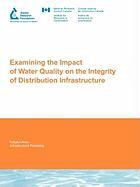Read more
Changes in regulatory restrictions on source-water withdrawals, treatment techniques, and maximum contaminant levels (MCLs) require utilities to constantly change, upgrade or altogether replace their historic water sources and treatment practices. Strategies to comply with state and national regulations on drinking water quality and quantity ultimately lead to changes in the chemistry of the water that comes in contact with the distribution networks. These changes might adversely impact the distribution infrastructure. The main objective of this research project was to identify research needs for evaluating water quality impacts on distribution infrastructure integrity. The research team planned to identify missing links in the complex interrelation among water quality regulations. These regulations drive new treatment technologies resulting in primary and secondary impacts on water quality in distribution systems, ultimately affecting the distribution infrastructure integrity.
Each water utility has it own set of challenges based on the source water used, demand dynamics, applicable regulations, condition of distribution infrastructure, operation, maintenance and renewal strategies, economic and management issues. The HRM proposed in this research allows each utility to predict the relative impact of changing treatment process and practices for its unique conditions.

